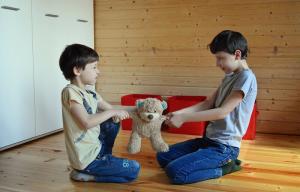Dyspraxia: types, causes, symptoms and treatment
Tying our shoelaces, eating, writing or combing our hair are activities that for most people can be easy and automatic. However, most of these activities involve a set of different actions and movements that we have to learn to coordinate.
But some people have serious difficulties in doing so since childhood, failing to develop that capacity. These are people with dyspraxia..
- Related article: "The 16 most common mental disorders"
Dyspraxia: definition of the concept
Dyspraxia or developmental coordination disorder It is one of the neurodevelopmental disorders, in which the boys and girls who suffer from it show great difficulty when to carry out coordinated activities and movements, involving simple gestures or actions that imply a sequencing of movements.
Symptoms
The most obvious symptoms are the presence of clumsiness, incoordination and slowness motor, interfering with the habitual life and the development of the subject. It is common to have difficulties in maintaining posture and when performing acts that require fine mobility, requiring help to perform basic actions.
Also immature behaviors and social difficulties may appear. It is not uncommon for there to be communication problems. However, these alterations have nothing to do with the existence of any mental disability, with those who suffer from dyspraxia having normal intelligence.
Unlike apraxia, in which previously acquired faculties are lost, dyspraxia is characterized because the subject has never developed the ability to correctly sequence their movements. It is frequent that the first symptoms are already observable during the first two years of age, being common that they present delays in the development of motor skills and take longer than usual to reach some developmental milestones.
Although it arises during childhood, it is also observed in adults, making it important to start treatment as soon as possible in order to reduce the social stigma and the possible consequences throughout the development. There tends to be comorbidity with other disorders, such as other motor problems or with ADHD.
types of dyspraxia
As with apraxias, there are different types of dyspraxia depending on the type of where in the movement process or body the difficulty occurs. Four types stand out in particular.
1. ideational dyspraxia
This type of dyspraxia is characterized by the fact that the problem is not only at the motor level, but the subject presents Difficulties to plan at the idea level the sequence of movements needed to perform a specific action.
2. ideomotor dyspraxia
In ideomotor dyspraxia, the main difficulty is in following the chain of movements necessary to carry out a simple action. The difficulty occurs only at the motor level, and the subject can perform the action correctly in imagination. Often the difficulty is linked to the use of an instrument or object.
3. constructive dyspraxia
It is a type of dyspraxia in which the sufferer has difficulty understanding spatial relationships and acting according to them. For example, a child with this problem will have trouble performing a copying an image or when organizing.
4. Oromotor dyspraxia or verbal apraxia
In this type of dyspraxia, the subject presents difficulties in coordinating the movements necessary to communicate orally, despite knowing what he wants to say. It is difficult to produce intelligible sounds.
Causes of dyspraxia
The causes of the appearance of dyspraxia are not fully known, but it is suspected that they are due to existing alterations throughout the neurodevelopment that cause the brain areas linked to the integration of motor information and its sequencing not to mature correctly. These brain areas are located at the back of the frontal lobes and around the fissure of Rolando.
It is usually due to inborn causes, but can be caused by injury, disease, and trauma during childhood.
Treatment and therapeutic strategies
Dyspraxia is a disorder that does not have a curative treatment, although it is possible to use different strategies in order to improve the adaptation of those affected to the environment and teach them to carry out the different Actions. Dyspraxia treatment is multidisciplinary, taking into account both the clinical and especially the psychoeducational.
In order to help these minors, strategies such as occupational therapy are often used to stimulate the subject and help develop her ability to move. Another element to highlight is physiotherapy.
Speech therapy is also usually essential in order to educate the child and allow him to develop the necessary coordination to be able to emit words correctly. At the educational level, it may be necessary to establish individualized plans that take into account the minor's difficulties.
The use of expressive therapy or techniques that promote the child's self-esteem, which may be diminished due to the perception of her difficulties, can also be very useful. Social skills training it also facilitates a correct link with the environment. Psychoeducation both for them and for the environment can be of great help in order to facilitate the normative development of the subject and the understanding of the existing difficulties in it.
- You may be interested in: "Types of psychological therapies"



